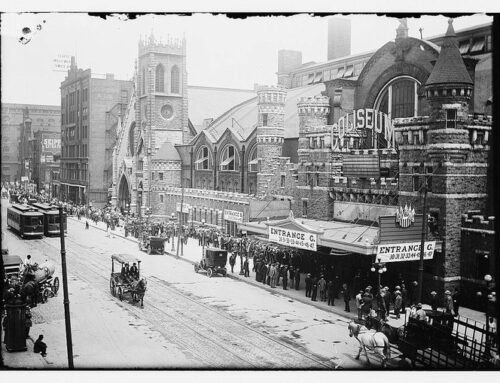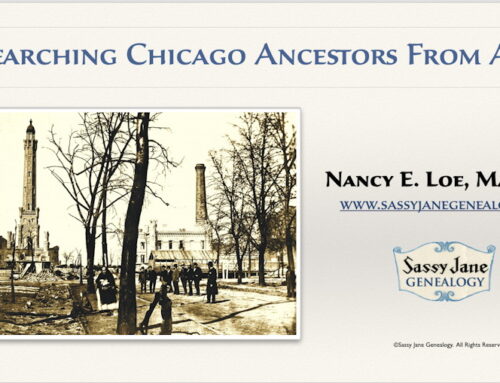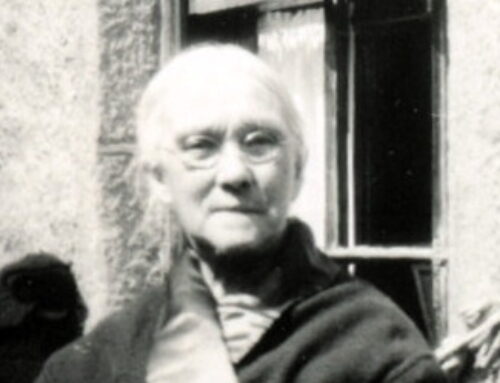This post is about finding Ross ancestors
in Tain in the Highlands of Scotland.
I’ve been on a mission to visit each of the eight Scandinavian and European villages of my immigrant great-grandparents. Our second ancestral trip sent us to the Scottish Highlands in 2017. First, we first visited Dunnottar parish in Kincardine, home of my Moncur and Jerves lines in the 18th century.
Ross Ancestors in Scotland
After that, I was determined to visit Ross, Mutch, and Will sites in Aberdeenshire and Tain. None of these are stops on the Scots-American Greatest Tourist Hits Highway. But they are my sites, and my cousins’.
Mary Mutch and George Ross, my great-grandparents, and their 10 surviving children, lived in at least seven places in Aberdeenshire. Uniformly, their children left school at the age of 10 to work in the local paper mill, where their father had risen to foreman.
The Last Rosses Leave for America
 In 1912, my grandfather decided to seek medical care in the US for his poor health. William was the youngest of the 10 known children of George Ross and Mary Mutch.
In 1912, my grandfather decided to seek medical care in the US for his poor health. William was the youngest of the 10 known children of George Ross and Mary Mutch.
My grandfather brought his parents with him on the voyage to America, just a month after the Titanic sank.
Family lore has always focused on George and Mary’s flat above the Woodend Bar, where my grandfather William was born.
But I was more interested in Mary and George’s ancestors in Tain. And of course my grandfather’s brothers and sisters, who left for Australia, New Zealand, South Africa, and Chicago, rather than work in that paper mill.
Finding Ross Ancestors in Tain
Eighteenth-century records had already pointed me to Tain, the seat of Clan Ross in the Highlands, 136 miles northwest of Aberdeen.
And I’d wanted to go there ever since discovering a new genealogy friend nearby who just happens to be a leading light of Clan Ross America, plus new cousins from Australia, who are generous and experienced researchers who’d been to Tain for the Clan Ross Gathering.
Looking for Rosses in Ross-shire
Looking for Rosses in Ross-shire is like looking for the proverbial needle in a haystack. That is, you’re really looking for specific pieces of straw in multiple haystacks! Here is my embarrassment of riches, where three lines of Ross ancestors in Tain converge:

Finding Ross Ancestors in Tain
It felt like the 136 miles from Aberdeen took 100 years, possibly because of my death grip on that right-sided steering wheel as this American drove (too slowly) down the opposite side of the road. My husband served as navigator and lookout. And as I narrowly avoided dry-stone walls, innocent children, sheep, mothers with babies, and elderly persons, George couldn’t help gasping – like a man saved over and over again from a submarine at the bottom of the sea – at each close call.
Visiting Tain as a Ross Descendant
And how nice are the Scots? Only one person, leaning out the window of his car, cherry-faced and hair whipping in the wind, shared choice and justified words with me when I started down exactly the wrong side of Tain’s High Street. The rest of the souls in that town were unsurprised that an American driver seemed intent on colliding head-on with them. Finally, we arrived at the Royal Tain Hotel, where we emerged from the car, spent and wan as death row inmates reprieved by a governor’s last-minute phone call. For dinner, I had Glenmorangie and a little haggis and George had haggis and a little Glemorangie – fixed us both right up.

My husband, at the end of my first day driving in Scotland, surprised to find himself alive and intact in Tain.
Tain Through Time
Then I was off to the Tain Through Time museum and archives. As I passed through the street entrance (see featured image at top), it made me feel happy and fortunate to realize my heritage travel might not be as indulgent as I’d thought. To me, it’s really is a form of genealogy pilgrimage.
The Tain museum is the heart of the community.
I’d made an appointment with museum staff member Jason, who generously had reviewed some of my research before I arrived.
All morning visitors arrived at the museum, both local and from afar. A volunteer with homemade fudge (“Sell the old stuff first!”); two hopelessly confused Russian tourists; another volunteer bringing objects he’d unearthed near the bay for examination (and reminding me of a favorite show, The Detectorists); more visitors; a local man wanting help on his family tree, conveniently stored on one crumpled sheet in his pocket; backpackers; a person sharing decided opinions on UK immigration policies. Through it all, Jason juggled me and the stream of visitors with ease.
As I watched this community gathering place in action, California seemed very far away. How could I not begin to daydream about extended time in Tain, where I could volunteer my archival skills to the museum, become a detectorist, photograph some graveyards, swap jokes about Lowlanders, admire George in a kilt, participate in Hogmanay? An archivist/genealogist can dream anyway.
Which George Ross?
Of my many Ross ancestors in Tain, Jason focussed on my great-great-great grandfather George Ross, who was baptized in Tain on 22 Nov 1785. He was listed as a pensioner in his 1829 burial record, indicating military service, possibly in the Napoleonic Wars. His wounds must have been serious enough that he was pensioned and sent home by 1810, when he would have been 25. Between 1810 and 1817, George and his wife Christian Fraser had four known children, all born in Ross-shire. But what I believed to be my ggg-grandfather George Ross in the 42nd Regiment of the Foot was eliminated when Jason found that particular George Ross being awarded medals in 1840. Now a different George Ross serving in the 78th Regiment of the Foot looks promising. More research to do!
Tain the Town
Tain Through Time also does a splendid job documenting the history of Tain as a seaport, royal burgh, and police burgh. It is a surpassingly lovely place. That Tain is so interesting a place is no surprise.
Noted author Daniel Dafoe published his three-volume travel chronicle, Curious and Diverting Journies Thro’ the Whole Island of Great-Britain between 1724 and 1727. His impressions:
Here we found the Town of Tain, and some other Villages tollerably well inhabited, and some Trade also, occasioned principally by the Communication with the Western islands, and also by the Herring Fishing, the fishing boats from other parts often putting into these ports; for all their Coast is full of Loughs and Rivers, and other Openings which make very good Harbours of Shipping….
We could understand nothing on this Side of what the People said, any more than if we had been in Morocco; and all the Remedy we had was, that we found most of the Gentlemen spoke French, and some few spoke broad Scots; we found it also much for our convenience to make the common People believe we were French.

George had had haggis for breakfast, lunch, dinner, then ordered a “Trio of Haggis Bombs, Clapshsot, Whisky Sauce.” But if he’s looking a bit green, it’s not the haggis. He knows he has to get back in the car again with me behind the wheel.
If you are fortunate enough to find yourself there (whether in search of Ross ancestors in Tain or not), do eat at Platform 1864, a restaurant with great food and wine and a staff to match. My other advice? If you’re from the U.S., take the train to Tain!
Next: More Highland travels finding Ross ancestors in Edderton and visiting Aberdeen’s Saint Peter’s Cemetery
Coming later this summer:
My next heritage trip is to Austria and my great-grandfather’s hometown in the Alps outside Innsbruck in July 2018.
And right after that, another genealogy pilgrimage to Poland to see my great-grandparents’ Posen and Pomeranian villages.
Ancestor Quests
- Ringebu, Oppland, Norway
- Øvre Eiker, Buskerud, Norway
- Dunnottar, Kincardinshire, Scotland
- Tain, Ross-shire, Scotland
- Ladis, Landeck, Tirol, Austria
- Rawitsch, Posen, Prussia, Part 1 and Part 2
- Freienwalde, Pomerania, Prussia
- Lindesberg, Örebro, Sweden (2019?)






Enjoyed your post, Nancy. Funnily enough I’m also looking for a George Ross supposed to be of Balnagowan but has the shield of the Rosses of Hawkeshead.
Like needles in haystacks!
You’ve inspired me to track my Rosses in Tain! I know my great grands are buried there and I think I’ve got some live cousins, too.
Do it, Lilla – it’s so much fun! Do you need help getting started?
So glad that the town of Tain survived your visit :) A fun story that made me laugh out loud several times, in addition to being interesting.
It was not nearly so funny at the time, but Tain, George, and I all survived!